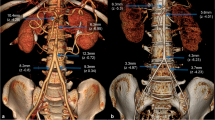Abstract
We studied the normal evolution over time of the diameter of the healthy descending aorta in patients suffering from aneurysm or dissection of the ascending aorta, in order to anticipate potential complications of endoprosthetic treatment in this aortic segment. During their follow-up (average 35.9 months), 52 patients suffering from aneurysm or dissection of the ascending aorta had 168 aortic MRI examinations (2―7; average 3). Measurements were taken according to conventional reference landmarks making it possible to study the evolution of the diameter of the supposed healthy descending thoracic aorta. The variations in diameter with time were on average 5 mm, and there was no significant variation in this diameter, either for early controls or for the controls carried out after more than 1 year or 3 years, whatever the age group. Thus according to our series it seems that patients with a descending aorta endoprosthesis are not exposed to graft endoleak due to inadequate contact of the prosthesis and aorta within the 5 years following its implantation.



Similar content being viewed by others
References
Bonser RS, Pagano D, Lewis ME, et al (2000) Clinical and patho-anatomical factors affecting expansion of thoracic aortic aneurysms. Heart 84:277–283
Fattori R, Napoli G, Parlapianio M, et al (1999) Endovascular treatment in diseases of the thoracic aorta. Radiol Med (Torino) 98:379–385
Garcier JM, Petitcolin V, Filaire M, et al (2003) Normal diameter of the thoracic aorta in adults: a magnetic resonance imaging study. Surg Radiol Anat 25:322–329
Greenberg R, Resch T, Nyman U, et al (2000) Endovascular repair of descending thoracic aortic aneurysms: an early experience with intermediate-term follow-up. J Vasc Surg 31:147–156
Hager A, KaemmererH, Rappy-Bernhardt U, et al (2002) Diameter of the thoracic aorta throughout life as measured with helical computed tomography. J Thorac Cardiovasc Surg 123:1060–1066
Hartnedl GG (2001) Imaging of aortic aneurysms and dissection: CT and MRI. J Thorac Imaging 16:35–46
Hashimoto S, Osakada G, Mori T, et al (1995) Transesophageal echocardiography in the diagnosis of thoracic saccular aortic aneurysm. The value of transesophageal echocardiography during the course of treatment. Int J Card Imaging 11:241–246
Ho VB, Prince MR (1998) Thoracic MR aortography imaging techniques and strategies. Radiographics 18:287–309
Mohr-Kahady S, Erbel R, Stuhn A, et al (1999) Quantitative detection of change in the thoracic aorta in patients with chronic aortic dissection using transesophageal echocardiography. Z Kardiol 88:507–513
Nienaber CA, Fatori R (2000) Aortic diseases—do we need MR techniques? Herz 25:331–341
Pasierski TJ, Binkley PF, Pearson AC (1992) Evaluation of aortic distensibility with transesophageal echocardiography. Am Heart J 123:1288–1292
Resnick LM, Militianu D, Cunnings AJ, et al (1997) Direct magnetic resonance determination of aortic distensibility in essential hypertension: relation to age, abdominal visceral fat, and in situ intracellular free magnesium. Hypertension 30:654–659
Rizzo JA, Coady MA, Elefteriades JA (1998) Procedures for estimating growth rates in thoracic aortic aneurysms. J Clin Epidemiol 51:747–54
Robin GD (1997) Helical CT angiography of the thoracic aorta. J Thorac Imaging 12:128–149
Rodrigues Alves CM, Da Fonesca JH, De Souza JA, et al (2002) Endovascular treatment of thoracic disease: patient selection—proposal of a risk score. Am Thorac Surg 73:1143–1148
Shimada I, Roney SJ, Farneti PA, et al (1999) Reproducibility of thoracic aortic diameter measurement using computed tomographic scans. Eur J Cardiothorac Surg 16:59–62
Slama MA, Benetos A, Pannier B, et al (1992) Non-invasive methods in the study of the elastic properties of the thoracic aorta. Effect of isosorbide dinitrate. Arch Mal Coeur Vaiss 85:47–50
Song JK, Kang DH, Lim TH, et al (1999) Different remodeling of descending thoracic aorta after acute event in aortic intramural hemorrhage versus aortic dissection. Am J Cardiol 83:937–941
Author information
Authors and Affiliations
Corresponding author
Rights and permissions
About this article
Cite this article
Benachenhou, K., Azarnouch, K., Filaire, M. et al. Evolution of healthy thoracic aortic segment diameter during follow-up of patients with aortic aneurysm or dissection: a magnetic resonance imaging study. Surg Radiol Anat 27, 142–146 (2005). https://doi.org/10.1007/s00276-004-0291-6
Received:
Accepted:
Published:
Issue Date:
DOI: https://doi.org/10.1007/s00276-004-0291-6




